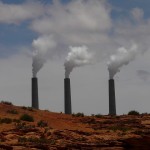Post 2 – Reflections and the global ‘to do’ list
For the last three days I have intermittently agonized about my last past. I feel strongly compelled to edit it – to reduce its length; to change its tone from something that is a cross between a corporate briefing document and a high school essay; to improve the review of the components of the calculator; to restructure the way I send an issue to my parking area; and, to offer a better carbon footprint calculator, that I realized I had identified but couldn’t find, prior to writing the post. I am not, however, going to edit it. I remind myself that it won’t be read by more than two people and I can apply my reflections and improvements to subsequent posts, starting with this one.
Yesterday, as I was reading through the articles in the aggregated news service that I use, I came across an interesting report. It is interesting for a number of reasons. First, it is interesting because it was under the heading ‘World News’ rather than a special section on climate change, that I specify that the service put together for me. Secondly, it is interesting because of its content. It reports on a legal action occurring in The Netherlands whereby the government is being sued through a class action claiming that it is not doing enough to protect it citizens from glob al warming of more than 2ºC which, therefore, violates their fundamental human rights. This is a ‘wow’ consideration for me although, on reflection, I shouldn’t be surprised. I think we should be talking about this, debating it in public and private or, at the very least, be able to participate in the discourse. The third reason that the article is interesting is that it reminds me quite specifically about emission targets. We need to make cuts in emissions of between 25 and 40% of 1990 levels by 2020 to have a 50% chance of avoiding a 2ºC rise in temperature. A 50% chance seems to me to be very poor odds. The point of the action is that the states of the European Union have signed up for these cuts by 2030 which is too late. These targets are at least the case for Europe and I will undertake to find out if they also apply to Australia (parked).
al warming of more than 2ºC which, therefore, violates their fundamental human rights. This is a ‘wow’ consideration for me although, on reflection, I shouldn’t be surprised. I think we should be talking about this, debating it in public and private or, at the very least, be able to participate in the discourse. The third reason that the article is interesting is that it reminds me quite specifically about emission targets. We need to make cuts in emissions of between 25 and 40% of 1990 levels by 2020 to have a 50% chance of avoiding a 2ºC rise in temperature. A 50% chance seems to me to be very poor odds. The point of the action is that the states of the European Union have signed up for these cuts by 2030 which is too late. These targets are at least the case for Europe and I will undertake to find out if they also apply to Australia (parked).
If I think about this article more widely, then the good news is that the people running this action have evidence that we have not yet reached the ‘tipping point’ (parked), whereby it is too late and global warming is irreversible. The not so good news is that Australian government has not signed up to anything significant, let alone cuts to emissions of between 25 and 40 per cent of 1990 levels. The debate in Australia over the Renewable Energy Target is not the same as the debate about emission levels, as far as I am aware. The really bad news for me is that even if we made the necessary cuts, we only have a 50% chance of keeping temperatures at or below 2ºC. I want to know what we have to do to have a better than 90% chance of 2ºC or less which really is the whole point of this blog. If you want to read the article, which is not very long, click on this link http://www.newscientist.com/article/dn27347-dutch-government-taken-to-court-over-climate-change.html#.VTGrhSGeDRY.
Well, to my two readers, I am going to finish here. The sun has just broken through this morning’s cloud cover and rain is predicted later so I want to set the washing machine going so it will be powered by our modest 1.5kW solar panels and I want to hang the overnight load of washing on the outside clothes line so it will dry somewhere other than in the house on clothes racks. These are the sort of day-to-day domestic considerations that make up one part of a low carbon life but one that is not low enough yet!
powered by our modest 1.5kW solar panels and I want to hang the overnight load of washing on the outside clothes line so it will dry somewhere other than in the house on clothes racks. These are the sort of day-to-day domestic considerations that make up one part of a low carbon life but one that is not low enough yet!
